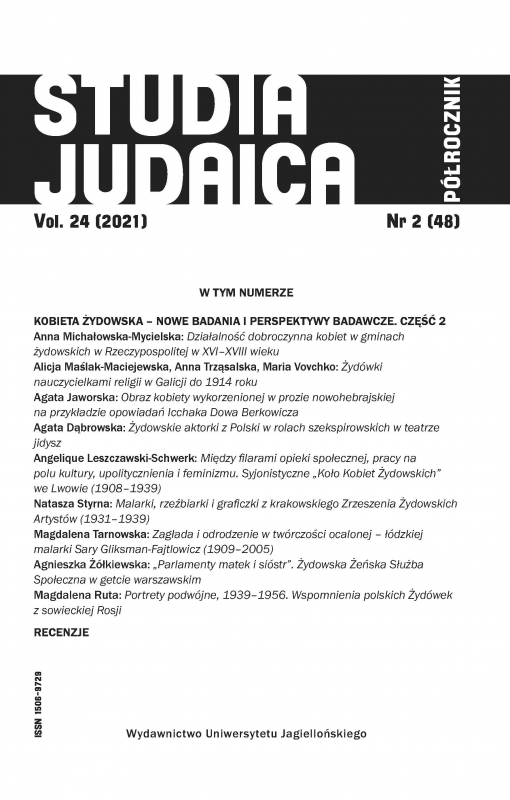Portrety podwójne, 1939–1956. Wspomnienia polskich Żydówek z sowieckiej Rosji
Double Portraits, 1939–1956: Memoirs of Polish Jewish Women From Soviet Russia
Author(s): Magdalena RutaSubject(s): Jewish studies, WW II and following years (1940 - 1949), Source Material
Published by: Wydawnictwo Uniwersytetu Jagiellońskiego
Keywords: literatura łagrowa; wspomnienia; łagry; zesłanie; ZSRR; stalinizm; Ola Watowa; Ruth Turkow-Kamińska; Szejna-Miriam Broderzon Aleksander Wat; Adi Rosner; Erika Rosner; Mojsze Broderzon; antysemityzm; Z
Summary/Abstract: During the first months following Germany’s attack on Poland, some members of the Jewish community managed to sneak away to the eastern frontiers of the country which had been invaded and annexed by the Red Army in the second half of September 1939. The tragic experiences of these refugees, heretofore somehow neglected by Holocaust scholars, have recently become the subject of profound academic reflection. One of the sources of knowledge about the fate of Jewish refugees from Poland are their memoirs. In this article the author reflects on three autobiographical texts written by Polish Jewish women, female refugees who survived the Holocaust thanks to their stay in Soviet Russia, namely Ola Watowa, Ruth Turkow Kaminska, and Sheyne-Miriam Broderzon. Each of them experienced not only the atrocities of war, but also, most of all, the cruelty of the Communist regime. All three of them suffered persecution by the oppressive Soviet authorities in different ways and at different times. While Ola Watowa experienced (in person, as well as through the fate of her family and friends) the bitter taste of persecution and deportation during WWII, Sheyne-Miriam Broderzon lived a relatively peaceful life in that period (1939–1945), and Ruth Turkow Kaminska even enjoyed the luxurious lifestyle reserved for the privileged members of the establishment, and it was not until the years immediately after the war that the latter two women would face the true image of Communism as its victims. The Wats managed to leave the USSR shortly after the war, whereas for the Broderzons and the Turkows the war would not end until the death of Stalin and their subsequent return to Poland in 1956. According to Mary G. Mason, the immanent feature of women’s autobiographical writings is the self-discovery of one’s own identity through the simultaneous identification of some ‘other.’ It is thanks to the rootedness of one’s own identity through the connection with a certain chosen ‘other’ that women authors can openly write about themselves. The aim of the article is to attempt to determine to what extent this statement remains true for the memoirs of the three Polish Jewish women who, besides sharing the aforementioned historical circumstances, are also linked by the fact that all of them stayed in romantic relationships with outstanding men (i.e. writers Aleksander Wat and Moyshe Broderzon, and jazzman Adi Rosner), which had an enormous impact not only on their lives in general, but also specifically on the creation and style of their autobiographical narratives, giving them the character of a sui generis double portrait.
Journal: Studia Judaica
- Issue Year: 24/2021
- Issue No: 48
- Page Range: 491-533
- Page Count: 43
- Language: Polish

